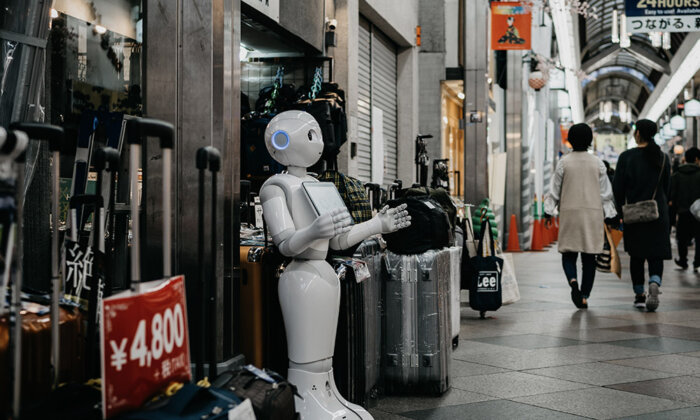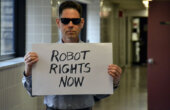When DIY Robots Invade

In 2004, ex-marine Rufus Terrill purchased a bar in downtown Atlanta, renamed it O’Terrill’s, and transformed it into an Irish-themed pub. Upset by the environment of vagrancy and drug activity around his establishment, he built a robot to keep away the riff-raff, and named it BumBot.
BumBot’s chassis was a three-wheel electric scooter; the torso a meat-smoker. Bright red lights on the robot were repurposed from a 1997 Chevrolet Camaro. A home-alarm loudspeaker system connected to a walkie-talkie allowed Terrill to admonish loiterers from afar. The robot had a moveable turret, including a bright spotlight and a high-pressure water cannon. Until O’Terrills closed a few years ago, the pub was signposted as “Home of the BumBot” and stocked BumBot-emblazoned T-shirts.

Two trends made a robot such as BumBot — and the reception it has received — possible. First, the cost and complexity of technology needed to make a custom, remote-control robot has decreased significantly. Almost anyone can, in a weekend, make a primitive robot, and the construction kits now available make that first robot larger, heavier, and stronger. The second trend is one of attitude. We, as a culture, celebrate scrappy DIY invention, through the world of Burning Man, Maker Faire, Craft, and other such outlets. By building a robot out of a variety of found parts, Terrill joined a celebrated club of enthusiasts who appreciate the idea of building a new device using parts in ways they were never originally intended to be used. Even with a purpose as ethically troubling as the BumBot’s, the aura of Terrill being a modern-day inventor provides an afterglow that softens the concerns many have regarding the actual details of what he does with the robot.
Over the next couple of decades, advances will transform DIY robotics, with the devices increasing in sophistication, diversity, and, most important, the degree to which they inhabit the same spaces we do. There will be millions of Terrills, and each one, with a unique agenda, moral compass, and vision, will make human-sized creations that embody his dreams in steel and bytes. This public democracy of built machines will be omnipresent and massively diverse. Could such a spectacular zoo imprison us?
Smog is a portmanteau that combines the natural and the artificial; fog simply reduces visibility, but when smoke and haze mix together, then quality of life decreases: Runners cough, tennis players’ lungs burn, and asthma cases in children bloom. Robot smog is a technological portmanteau: The visions of people, usually communicated through pen and voice, will soon adhere to the sidewalks and atmosphere of our physical world in literally invasive forms. There is a danger that we might suffocate in this world of dreams gone real. Could commercial robots such as solar-powered toys become both so autonomous and so easy to modify that we find our parks infested with robot inventions that will not leave us alone?
In this robot future, personal opinions are not just communicated; they are acted out by chaotic ecologies of robot minions.
The history of the Internet contains a similar, albeit highly constrained, example that parallels the concept of robot smog. By the late 1990s, everyone wanted to author their own website. But creating a new website meant writing in HTML, a type of computer specification for websites, and this in turn demanded knowledge of computer languages with a sophistication originally reserved for computer programmers. This changed abruptly with the advent of Macromedia Flash, hand in hand with interactive software, such as FlashToGo, designed so that nonprogrammers could prototype and publish entire websites with no prior graphic design or computer programming experience.
The new tools catalyzed a great increase in the number of websites published every week, and many of them were filled with animated widgets blazing away thanks to Flash: butterflies flapping, hearts beating, words blinking, clip art breezing across the screen. Of course, the results were aesthetically unappealing, with clichéd, poorly designed, and annoyingly loud websites germinated and rapidly reproduced in a few short years. But the downstream effects of this new, easy publication process were far more profound. The Internet became everyman’s stage. Like a soapbox in the town square but with a megaphone that reaches the ears of millions of neighbors, every person with an hour of time was empowered to espouse her own world view, her own personal politics online. This, in turn, led to a Balkanization of the Internet as more and more extreme ideas attracted the readership of like-minded souls, and the ethics of moderation and compromise lost out to extremes, exclusion, and exaggeration.
The parallel to robotics is straightforward. Technologies will make it far easier for anyone to make a custom robot over the next decade. Will this result in a zoo of obnoxious, exotic new creatures? The early explosion of animated websites was confined to the Internet. You could stand up and walk away from a loud website by simply leaving your desk. Even today’s creative explosion of smartphone applications is limited in scope — they are inside your phone, and you can choose just which ones you download and use. But future robotic creations will be physically omnipresent. When your neighbor down the street makes it and sets it free, you may have to wrestle it out of your vegetable garden the next day. In this robot future, personal opinions are not just communicated; they are acted out by chaotic ecologies of robot minions.
Illah Reza Nourbakhsh is K&L Gates Professor of Ethics and Computational Technologies in the Robotics Institute at Carnegie Mellon University. He is co-author of the forthcoming book “AI and Humanity” and author of “Robot Futures,” from which this article is adapted.


